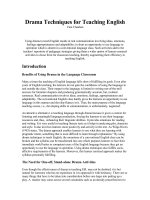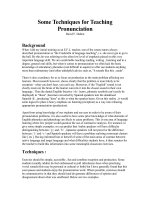Classroom Techniques for Contextualization
Bạn đang xem bản rút gọn của tài liệu. Xem và tải ngay bản đầy đủ của tài liệu tại đây (63.86 KB, 2 trang )
Classroom Techniques for
Contextualization:
How to make "This is a pen." a
pragmatically motivated utterance
Yoshinori Sasaki
It has long been recognized that the insufficiency of the audiolingual training in fostering
functional communicators is partly due to unrealistic pseudo-communication prevalent in a
classroom (Omaggio-Hadley, 1993). A huge number of such transactions as "Is that a
pencil?"-"No, it isn't. It is a pen." (Ota, Ito & Kusakabe, 1980, p.7) are conducted solely for
the purpose of structural pattern practices, without participants' intrinsic motivation to
make such utterances: Answers are often so obvious that there is no reason to ask them
(unless the inquirer is trying to confirm the meanning of the word, or s/he is
perceptually/cognitively deficient.) Sometimes teachers under a strong curriculum
constraint are forced to have their students practice such model dialogues which are
presented in a textbook. This is regrettable because lack of a pragmatic motivation behind a
question makes subsequent classroom communication less active (Long, Brock, Crookes,
Deicke, Potter, & Zhang, 1984).
Fortunately, techniques have been developed to contextualize such utterances so that they
make pragmatic sense within the provided situation. This paper summerizes some of such
techniques.
Techniques for Contextualization
Technique #1: Use abstract arts
Show Pablo Picasso's abstract picture and ask such questions as "Is this a woman?".
Variation: * Use ethnic arts, such as Japanese folding paper arts (Aoki, Ikeura, Ide,
Kaneda, Sato, Sato, Shimaoka, Hayasaka, & Nitani, 1983) and African masks.
Technique #2: Use a disguise
Show a picture of an actor on a female makeup (e.g., Japanese Kabuki play) and of real
women, and have students guess their gender. Variations: * Ask the real function of goods
of unusual shapes (e.g., a video-tape rewinder which looks like a car toy.) * Present tape-
recorded voices of men and women; Some of the men have high-pitch voices, and some of
the women have low-pitch voices. Have students guess their genders.
Technique #3: Reduce available perceptual information
Initially show students only a small portion of an object/person (e.g., the chin portion of a
picture of a well-known actor), and gradually expose the rest, until one of the students
comes across a correct answer who/what it is. Variation: * Put a pen, a wrist watch and a
pencil each in a brown bag, and shuffle them rapidly before students' eyes. After that, point
a bag and ask students, "Is this a pen?"
Technique #4: Introduce a change of state
Aoki, Ito, Endo, Ootomo, Kitaichi, Nakamura, Matsui, Morizumi, Morinaga, Wakabayashi,
Hattori, and Dobbyn (1983) cleverly contextualize "This is an egg." and "That is a bird." as
utterances of a conjurer who transforms an egg into a bird. Variation: * Use one of the
growing number of digital movies in which an item seamlessly transforms into a different
one.
Technique #5: Take advantage of cultural knowledge gaps
In the absence of a speaker's solid knowledge about local American culture, asking such
questions as "Is he an Amish?" makes sense with reference to a picture of a person in a folk
costume. This type of activities can also lead to a fruitful cultural discussion.
Conclusion
Foreign language teachers sometimes come across pragmatically unmotivated model
dialogues in a textbook. However, it is often possible to make those seemingly nonsense
utterances a motivated one by providing an appropriate context, so that transactions in class
provide a realistic communication.







![understanding adobe photoshop cs6 [electronic resource] the essential techniques for imaging professionals](https://media.store123doc.com/images/document/14/y/ld/medium_ldp1401378034.jpg)

